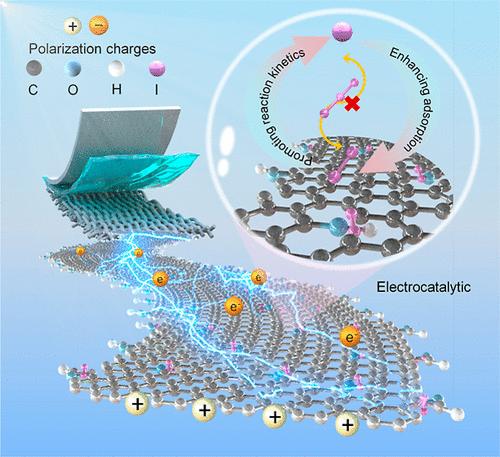利用羟基进行热力学和动力学促进电催化碘转换,从而实现高效锌碘电池
IF 8.3
2区 材料科学
Q1 MATERIALS SCIENCE, MULTIDISCIPLINARY
引用次数: 0
摘要
可充电锌碘(Zn-I2)电池在电网规模的储能应用中展现出了巨大的潜力,但由于碘还原反应(IRR)动力学迟缓以及聚碘化物严重的穿梭问题,提高效率和循环稳定性仍面临挑战。我们在本文中展示了一种高效的无金属羟基(-OH)功能化碳催化剂,它能有效提高 Zn-I2 电池的性能。研究发现,所获得的电催化性能与碳基质中的表面氧化学环境密切相关。理论计算和实验测量均发现,-OH 基团而非羰基(-C═O)和羧基(-COOH)为 IRR 提供了活性电催化位点,改善了碘氧化还原动力学和电化学可逆性,并促进了 I2 成核。一系列原位和非原位光谱技术证实,由于 O-H-I 通道具有良好的反应热力学特性,并降低了 I3- 的解离能垒,因此可以有效地引发 I2/I- 的直接转化,避免形成稳定的多碘化物。因此,I2/氧官能化碳布(I2/OCC-2)//Zn组装电池在1 mA cm-2时具有2.27 mA h cm-2的高容量,在20 mA cm-2时具有89.0%的容量保持率和10,000次循环的长期稳定性。本文章由计算机程序翻译,如有差异,请以英文原文为准。

Thermodynamically and Dynamically Boosted Electrocatalytic Iodine Conversion with Hydroxyl Groups for High-Efficiency Zinc–Iodine Batteries
Rechargeable zinc–iodine (Zn–I2) batteries have shown immense potential for grid-scale energy storage applications, but there remain challenges of improving efficiency and cycling stability due to the sluggish iodine reduction reaction (IRR) kinetics and serious shuttle problem of polyiodides. We herein demonstrate an efficient metal-free hydroxyl (−OH)-functionalized carbon catalyst that effectively boosts the performance of Zn–I2 batteries. It has been found that the obtained electrocatalytic performance is strongly correlated with the surface oxygen chemical environment in the carbon matrix. Both theoretical calculations and experimental measurements have uncovered that the −OH group, rather than carbonyl (−C═O) and carboxyl (−COOH), provides the active electrocatalytic site for IRR, improves the iodine redox kinetics and the electrochemical reversibility, and facilitates I2 nucleation. As confirmed by a series of in situ and ex situ spectroscopy techniques, due to the favorable reaction thermodynamics and the lowered energy barrier for I3– dissociation, the O–H···I channels can effectively trigger the direct transformation of I2/I– and avoid the formation of stable polyiodides. As a result, the as-assembled battery of I2/oxygen-functionalized carbon cloth (I2/OCC-2)//Zn exhibits a high capacity of 2.27 mA h cm–2 at 1 mA cm–2, outstanding rate capability with 89.0% capacity retention at 20 mA cm–2, and long-term stability of 10,000 cycles.
求助全文
通过发布文献求助,成功后即可免费获取论文全文。
去求助
来源期刊

ACS Applied Materials & Interfaces
工程技术-材料科学:综合
CiteScore
16.00
自引率
6.30%
发文量
4978
审稿时长
1.8 months
期刊介绍:
ACS Applied Materials & Interfaces is a leading interdisciplinary journal that brings together chemists, engineers, physicists, and biologists to explore the development and utilization of newly-discovered materials and interfacial processes for specific applications. Our journal has experienced remarkable growth since its establishment in 2009, both in terms of the number of articles published and the impact of the research showcased. We are proud to foster a truly global community, with the majority of published articles originating from outside the United States, reflecting the rapid growth of applied research worldwide.
 求助内容:
求助内容: 应助结果提醒方式:
应助结果提醒方式:


